Picture this: a spider with a striking black body and the red hourglass-shaped mark on its underside, lurking in your basement or hiding in a corner of your garage. If you reside in North America, you may have spotted one or two Black Widow spiders. But did you know that there are significant differences between male and female Black Widow spiders? Male vs Female Black Widow Spiders: What Makes Them Different? It may surprise you to learn that these arachnids aren’t as similar as they may appear at first glance. In this article, we’ll outline the characteristics and behaviors that distinguish male and female Black Widow spiders and share some tips for staying safe and pest-free.
Appearance
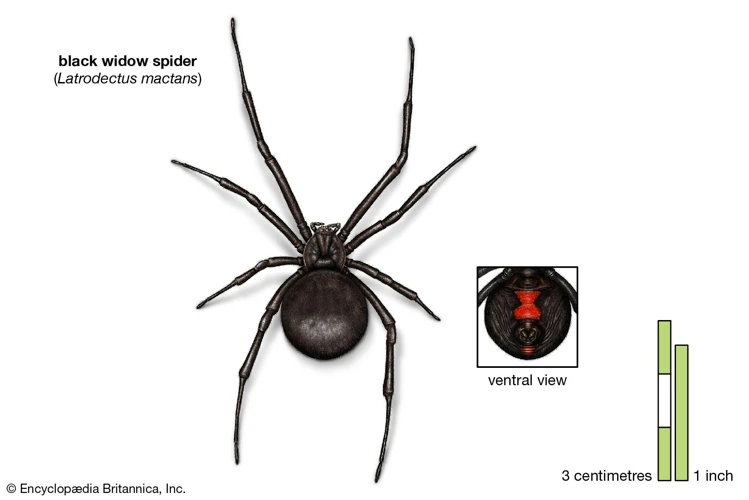
One of the most distinctive characteristics of black widow spiders, aside from their potent venom, is the difference between male and female spiders’ appearance. Males and females have unique physical features, which can make it easier for you to determine their gender. In the following sections, we will discuss the differences in size, color, and physical characteristics of male and female black widow spiders. Understanding how to differentiate between the two can help you spot them around your home and help prevent infestations.
Differences in Size and Color
Male and female black widow spiders are different in size and color. Here are the key differences between male and female black widows:
- Size: Female black widows are generally larger than males, with females measuring up to 1.5 inches in size, while males measure around half this size.
- Color: Female black widows are known for their shiny black color with a distinctive red hourglass marking on the underside of the abdomen. Males, on the other hand, have a tan or brownish color with yellow or red bands across the back. The red hourglass marking on the female’s underside is absent or incomplete in the males.
It is essential to be able to differentiate between male and female black widows, especially if you suspect a spider infestation in your home or backyard. Further, understanding the physical characteristics of male and female black widows can help you exercise caution in situations where you’re likely to encounter these spiders. To learn more about identifying black widows, check out our article on Identifying Black Widow Spider Webs.
Morphological Differences/Physical Characteristics
Male and female black widow spiders have different physical characteristics. Physically, male black widows are smaller than their female counterparts. While female black widows can grow up to 1.5 inches in length with a leg span of 3 inches, males are usually less than half that size. Male black widows are typically around 0.75 inches long with a leg span of around 1.5 inches. This difference in size is one way to differentiate between male and female black widow spiders.
Another obvious physical difference between male and female black widow spiders is their coloration. Female black widows are usually black all over with a distinct red hourglass shape on their abdomen. In contrast, male black widows are usually a brown color with white, yellow, or red stripes along the sides of their abdomens. Some males may have an additional white or yellow spot on their abdomen or back.
In terms of their body shape, male and female black widows have different morphological differences. Female black widows have a bulbous abdomen and a smaller head. Male black widows have a less rounded abdomen and a larger head that is almost the same size as their body. Male black widows also have longer legs than female black widows relative to their body size.
The physical differences between male and female black widow spiders include size, coloration, and body shape. Knowing these morphological differences can help in identifying which gender of black widow spider you are dealing with. It is important to note that while male black widows are not as dangerous as females, they can still bite and should be handled with care.
Behavior Characteristics
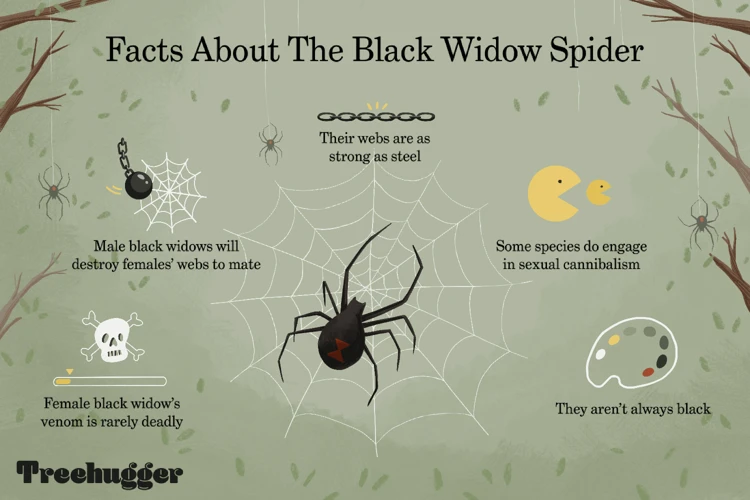
When it comes to understanding the difference between male and female black widow spiders, their behavior characteristics play a vital role. These distinct behavioral differences can help you identify the gender of a black widow spider and anticipate their actions. From mating habits to courtship behavior, and more, it’s crucial to learn all about their conduct to ensure your safety. So, without further ado, let’s explore the fascinating behavior characteristics of male and female black widow spiders. And if you’re concerned about black widow spiders infesting your home, we have included some internal links to guide you on preventing their entry and staying safe.
Males’ Courtship Behavior
Male black widow spiders have unique courtship behavior, which differs from other spider species. During the mating season, males will search for females and approach them with a specific set of actions. This behavior is crucial as males are at risk of being attacked and eaten by the larger female if she perceives him as a threat. Here are the key features of male black widow spider courtship behavior:
| Behavior | Description |
|---|---|
| Web-vibration Ritual | Male black widow spiders are known to vibrate female’s webs to communicate their intentions and approach them non-threateningly. They do this by plucking strands of the female’s web in delicate rhythms, making her aware of their presence while avoiding confrontation. |
| Secretions | Males also emit special pheromones while vibrating the web. These pheromones are strongly attractive to the female and help ensure she is aware of the male’s presence without triggering her aggression. |
| Gift-giving | Male black widow spiders may offer a food gift to the female, typically an insect, as a way of showing his good intentions and intentions to mate. |
| Mating Dance | When the female is aware of and accepts the male’s presence and gift, he will approach her for mating. The male spider will use a series of elaborate leg movements and vibrations to coordinate movements and align with the female’s reproductive openings. |
It is crucial to note that black widow spiders are dangerous, and individuals should not attempt to approach, capture, or handle them. Instead, the safest approach is to contact a professional pest control specialist to handle a potential black widow infestation.
If you are dealing with a black widow spider infestation, it is essential to understand how to stay safe while handling the problem. For more information on how to keep yourself and your home protected from black widows, check out our comprehensive guide on black widow spiders in homes, including preventing black widows from entering your home, home safety tips, and natural remedies for keeping these spiders away. In the event of a black widow spider bite, it is essential to know how to perform first aid and when to seek medical attention, including antivenom.
Females’ Aggressiveness
Female black widow spiders are known for their notoriously aggressive behavior, a trait that most likely arose due to natural selection pressures. As males are much smaller in size and have shorter life expectancy than females, they tend to have a more passive behavior, whereas females are more territorial and protective of their egg sacs.
To put it simply, female black widow spiders are highly aggressive and pose a serious threat to humans and other animals that trespass their territory. When disturbed or provoked, female black widows will bite without hesitation, and their venom can be harmful or even deadly to humans. The venom contains a neurotoxin that attacks the victim’s nervous system, causing muscle spasms, pain, and sometimes even paralysis. It’s essential to stay away from female black widows and their nests.
To give you an idea of just how aggressive female black widows can be, the following table shows some of the most common aggressive behaviors exhibited by female black widows:
| Aggressive Behavior | Description |
|---|---|
| Biting | Female black widows will bite if they feel threatened or disturbed.[1] |
| Aggressive posture | They will raise their front legs and show their fangs as a warning sign to intruders. |
| Web-shaking | Female black widows will shake their webs vigorously, causing nearby objects to vibrate, as a warning sign.[2] |
| Spitting | They may spit venom at an intruder as a defense mechanism. |
| Nest Guarding | Female black widows are highly territorial and will fiercely defend their egg sacs and nest from intruders.[3] |
Despite their aggressive nature, it’s important to remember that black widow spiders do not go out of their way to harm humans and will only attack if they feel threatened. If you suspect a black widow infestation in your home, it’s best to call a pest control professional to handle it safely. There are also natural remedies available that can help keep black widows away from your property without using harmful chemicals. Check out our article on natural black widow remedies for more information.
Reproduction Differences
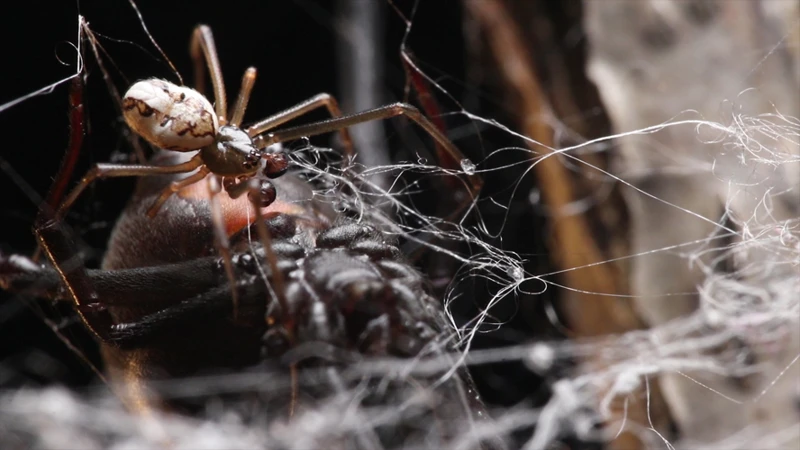
Reproduction is a vital aspect of any species’ survival. In the case of Black Widow spiders, there are some remarkable differences in the way males and females approach the process. These differences go beyond just the physical attributes of the two genders and can also affect their behaviors and life cycles significantly. Let’s delve deeper into the interesting reproduction differences between the male and female Black Widow spiders.
Mating Habits
Male and female black widow spiders have distinct mating habits. Mating is a significant events in their life cycle, and it plays a crucial role in their survival and reproduction. Here are some important points to consider about black widow spider mating habits:
- Males initiate the courtship: During mating season, male black widow spiders will go in search of females to mate with. They begin the process by approaching a female’s web and starting a courtship ritual, which can take several hours.
- The courtship ritual: The male black widow spider will start the courtship process by tapping on the female’s web to get her attention. He then slowly approaches her, often carrying a gift of food. The male will then use his forelegs to touch and probe the female’s web, producing vibrations that are a key part of the courtship display.
- Mating: Once the male has succeeded in getting the female’s attention and has established his intentions, he will carefully approach her and mate. The female may become aggressive during this process, and if she is not receptive, she may attack and kill the male.
- Multiple mates: Male black widow spiders will often mate with multiple females during mating season, while females tend to mate only once or twice during their lifespan.
- Cannibalism: Cannibalism is a notable part of black widow spider mating. In some cases, the female may kill and eat the male after mating, depending on various factors such as hunger and stress.
It’s important to note that black widow spider mating habits can vary depending on the specific species and individual behavior. However, the above points are generally observed in male and female black widow spider mating behavior.
Females’ Fertility and Offspring Production
Female black widow spiders are known for their remarkable fertility and the large number of offspring they produce. This is due to their ability to store sperm for a long period of time, allowing them to fertilize multiple egg sacs without requiring additional mating.
In terms of fertility, female black widows are capable of producing up to nine egg sacs over their lifespan, each containing between 250 and 750 eggs. The eggs will hatch within a few weeks, and the spiderlings will emerge, ready to begin their own journey.
Female black widows are also known for their maternal instincts. The mother spider will fiercely protect her offspring and will even tolerate aggression towards herself in order to ensure their safety. This level of care is atypical for spiders, making black widows unique in this sense.
To better illustrate the differences between male and female black widows in terms of fertility and offspring production, the following table summarizes the key points:
| Characteristic | Male Black Widow Spiders | Female Black Widow Spiders |
|---|---|---|
| Fertility | Do not produce eggs | Capable of producing up to nine egg sacs over their lifespan, each containing between 250 and 750 eggs |
| Offspring Production | Do not produce offspring | Produce spiderlings through eggs that hatch within a few weeks of being laid |
Female black widows are much more prolific than males when it comes to reproductive ability. Their ability to produce numerous egg sacs throughout their lives, each containing hundreds of eggs, ensures that the black widow spider population remains strong and stable. However, this also means that if left unchecked, an infestation of black widow spiders can quickly become out of control.
How to Differentiate Them
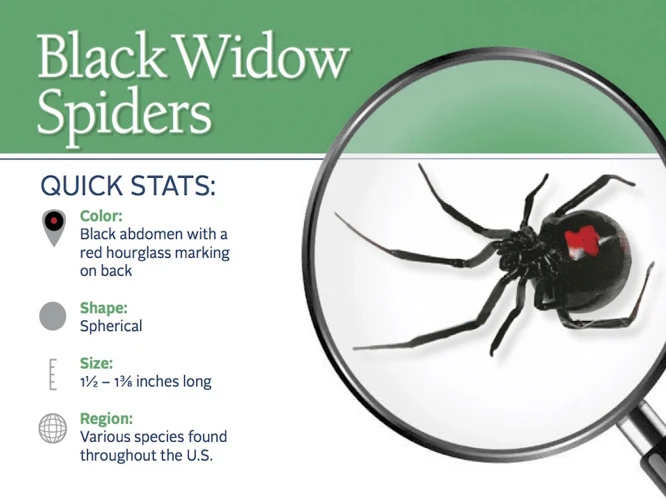
When it comes to distinguishing between male and female black widow spiders, it may seem challenging at first glance due to their similarities. However, there are several distinct physical and behavioral characteristics that set them apart. Knowing how to differentiate between the two can help identify potential mating partners or prevent dangerous situations. In this section, we will explore various ways to tell male and female black widow spiders apart using identifying features.
Identifying Male and Female Black Widow Spiders
When it comes to identifying male and female black widow spiders, there are several physical characteristics that set them apart.
1. Size: Male black widows are typically smaller than females, which can grow up to 1.5 inches in length. Males usually only reach around half that size.
2. Color: While both male and female black widows are black in color, females have a red hourglass-shaped marking on their abdomen. Males, on the other hand, have white or yellowish markings on their backs.
3. Abdomen shape: Females have a round abdomen, while males have a more elongated, narrow abdomen.
4. Spinnerets: Spinnerets are the organs spiders use to spin webs. Female black widows have six spinnerets, while males only have two.
5. Pedipalps: Pedipalps are the appendages near a spider’s mouth that are used for mating. Males have enlarged pedipalps with a bulbous tip that they use to insert sperm into the female during mating.
6. Behavior: Male black widows are more agile and faster than females, and they tend to move around more. Females are usually found in webs or hidden areas and are less likely to be seen moving around.
Knowing how to identify male and female black widow spiders is important for several reasons. It can help you identify potential breeding pairs if you want to control an infestation, and it can also help you stay safe by avoiding the more dangerous female spiders. If you’re unsure if the spider you’re seeing is a male or female black widow, it’s best to contact a pest control professional for assistance.
Home Remedies to Encourage Separation of Males and Females From Homes
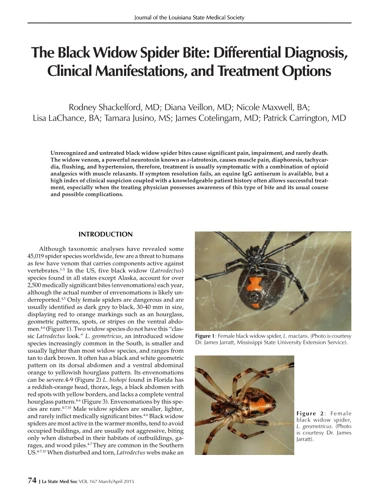
If you have a black widow spider infestation in your home, it is important to take action to separate the male and female spiders to prevent mating and reproduction. There are some home remedies that can help encourage separation of the male and female black widow spiders.
Aromatic Herbs and Essential Oils
One way to encourage separation of black widow spiders is to use aromatic herbs and essential oils. These scents can be unpleasant to spiders and may make them want to move away from the area. Some herbs and essential oils that are effective include peppermint, lavender, eucalyptus, and citronella. You can use these oils in a spray bottle mixed with water and spray around areas where spiders frequent. Alternatively, you can place sachets or cotton balls soaked in essential oils in the corners of rooms and near spider webs.
Citrus Peels
Black widow spiders don’t like the scent of citrus, so placing citrus peels in areas where spiders are active can help encourage separation. You can place orange or lemon peels in areas such as doorways, windowsills, and corners of rooms. This can help keep spiders at bay and prevent them from reproducing in your home.
Vacuuming
Vacuuming up spider webs and eggs can help prevent black widow spiders from reproducing in your home. Pay special attention to areas where spiders are active, such as corners, closets, and garages. Be sure to dispose of vacuum bags or contents immediately after vacuuming to prevent spiders from escaping back into your home.
Sealing Cracks and Openings
It’s important to seal up any cracks and openings in and around your home to prevent black widow spiders from entering. Check for gaps around doors and windows, as well as openings in walls, ceilings, and floors. You can use caulk or weatherstripping to seal these gaps and keep spiders out.
Decluttering
Cluttered areas such as garages and basements provide ideal hiding spots for black widow spiders. By decluttering and organizing these areas, you can reduce the number of hiding spots for spiders and make it easier to vacuum up webs and eggs. It’s also important to store items off the ground to prevent spiders from nesting in or under them.
There are several home remedies you can try to encourage separation and prevent reproduction of male and female black widow spiders in your home. Using a combination of these methods can help keep your home spider-free and reduce the risk of spider bites.
How to Stay Safe From Black Widow Spider Bites
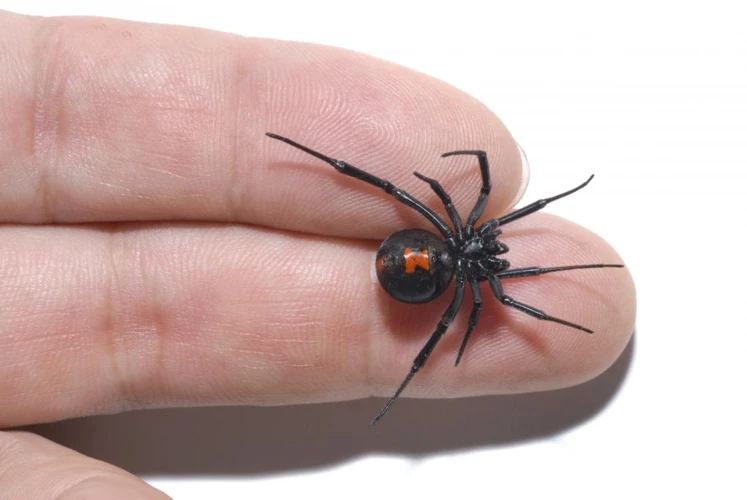
Black widow spider bites can cause serious health issues, especially to children and individuals with weak immune systems. The venom injected by these spiders can cause symptoms such as muscle pain, cramps, headaches, fever, and even paralysis. It’s important to take precautions to stay safe from black widow spider bites.
1. Wear Protective Clothing: When working or spending time in an area where black widow spiders are known to be present, it is important to wear protective clothing such as gloves and long-sleeved shirts and pants to avoid direct contact with these spiders.
2. Inspect Areas: Regularly check and inspect areas where black widow spiders are likely to live such as cluttered spaces, holes in walls, and sheds. This helps you identify and remove them from these areas.
3. Use Insecticides: You can use insecticides to eliminate and control black widow spiders. However, it’s important to read the instructions carefully before use, and wear protective gear such as gloves and goggles.
4. Clear Cluttered Areas: Cluttered spaces attract and provide breeding grounds for black widow spiders. By clearing these cluttered spaces, you remove hiding places for these spiders, making them more visible and easier to handle.
5. Call Professional Help: If you find any infestation of black widow spiders in or around your home, contact professional pest control services to eliminate them safely.
Staying safe from black widow spiders goes beyond just avoiding direct contact with them. It is important to keep your surroundings clean and free of clutter, wear protective gear when necessary, and take advantage of professional help when needed to ensure your safety and that of your loved ones.
The Life Cycle of Male and Female Black Widows
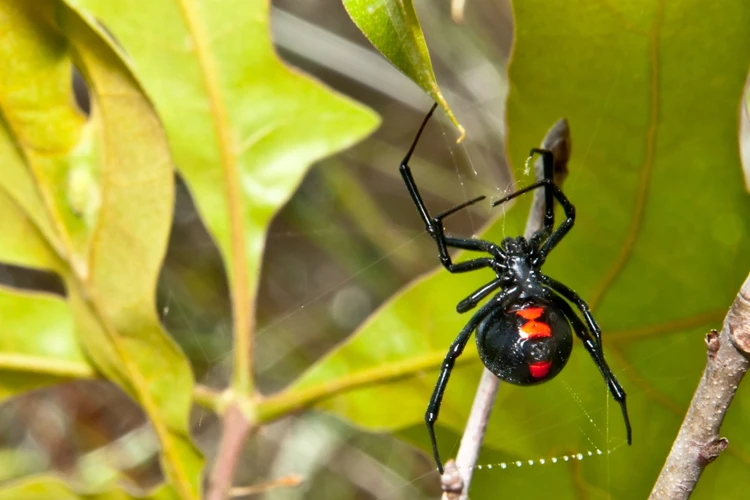
As with all living creatures, black widow spiders undergo a series of developmental stages throughout their lifespan. Understanding the life cycle of male and female black widows can help us identify them more easily and take preventative measures against infestations. From hatching to adulthood, these fascinating arachnids go through various changes and behaviors that set them apart from other spider species. In this section, we will explore the different stages of the black widow spider’s life cycle and the distinctions between males and females.
Developmental Stages
Male and female black widow spiders go through similar developmental stages, which include three stages: egg, nymph, and adult. Each stage is crucial for the survival of the species, and each stage has unique characteristics that set it apart from the others.
Egg Stage: Female black widow spiders lay their eggs in silken sacs, which are then attached to a secure location, such as a crevice, plant, or another surface. The female protects her eggs fiercely and will attack anything that tries to harm them. Depending on the species and environmental conditions, it takes about 20-30 days for the eggs to hatch.
Nymph Stage: Once the eggs hatch, the spiderlings enter the nymph stage. This stage is crucial for the spider’s development as they shed their skin several times to reach maturity. At each stage, the spiderlings grow larger, and their physical characteristics become more defined. During this stage, spiderlings are vulnerable to predation and must remain hidden to survive.
Adult Stage: Once the spider reaches maturity, it enters the adult stage. The male and female black widow spiders look different during this stage, and the females are usually larger and darker in color. Females have the characteristic red hourglass shape on their abdomen, while males have a narrower and elongated body.
During the adult stage, they mate, lay eggs, and hunt for prey. Depending on the species and environmental conditions, the lifespan of a female black widow can range from several months to several years, while males usually die soon after mating.
It’s essential to understand the developmental stages of black widow spiders. Knowing these stages helps identify spider infestations early and take corrective measures to control them before they become a considerable problem. If you suspect a black widow spider infestation in or around your home, it’s advisable to contact professional pest control services to ensure the safety of you and your family.
Life Span of Both Genders
It is fascinating to learn about the life span of both male and female black widow spiders. Research indicates that the female black widow spiders have a longer life span than the male spiders.
The life span of female black widow spiders is usually 1-3 years in the wild, while in captivity, they can live up to five years. On the other hand, male black widow spiders have a significantly shorter lifespan. Typically, they survive only for a few months, and once they reach sexual maturity, they begin searching for a mate.
To better understand the differences between the life spans of both genders, we can compare them side by side in the following table:
| Female Black Widow Spiders | Male Black Widow Spiders | |
|---|---|---|
| Average Wild Life Span | 1-3 years | Few months |
| Average Captive Life Span | Up to 5 years | – |
It is important to keep in mind that the life span of black widow spiders can vary based on several factors, such as temperature, habitat, food availability, and other environmental conditions. However, the general trend of females having a longer life span than males holds true across different regions and study groups.
Knowing the life span of black widow spiders is helpful in understanding their behaviors and population dynamics. For instance, since males have a shorter life span and are typically smaller in size, they have to be extremely cautious during mating to avoid getting attacked or devoured by the females. Additionally, longer life spans for females can mean more chances of successful reproduction and higher population growth rates.
The differences in the life spans of male and female black widow spiders play a significant role in their behaviors and survival strategies, making them fascinating creatures to study.
Signs of Infestation
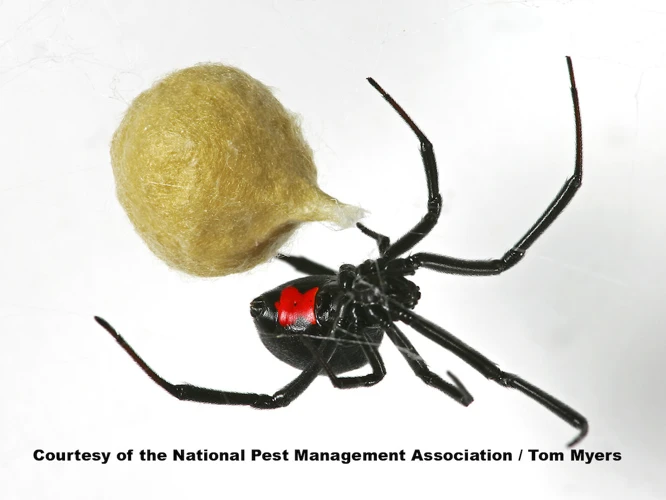
It is important to be able to identify signs of black widow spider infestation in and around your home in order to take necessary preventative measures. One of the most obvious signs of infestation is the presence of spider webs, which usually indicates that there is more than one spider in the area. Black widows often make their webs in undisturbed locations such as garages, attics, basements, and other dark and cluttered areas.
Another way to identify an infestation is by the presence of black widow spiders themselves. Both male and female black widows are easily recognizable by their glossy black color and the red hourglass-shaped marking on their abdomen. Females are typically larger than males, measuring up to 1.5 inches in length, while males are much smaller, measuring only about half an inch. Typically, females are more frequently found inside homes, while males are more common outside.
In addition to webs and spider sightings, another sign of infestation is the presence of egg sacs. Female black widows are known to produce several egg sacs over their lifetime, each of which contains hundreds of eggs. These sacs are usually white in color and can be found in dark corners or crevices, often near the spider’s web.
If you suspect that you have a black widow spider infestation, it’s important to take immediate action to reduce the risk of bites. This may involve consulting with a pest control professional who can safely remove the spiders and their webs from your home. By being aware of the signs of black widow spider infestation and taking preventative measures, you can help protect your home and family from these dangerous spiders.
Risks and Dangers
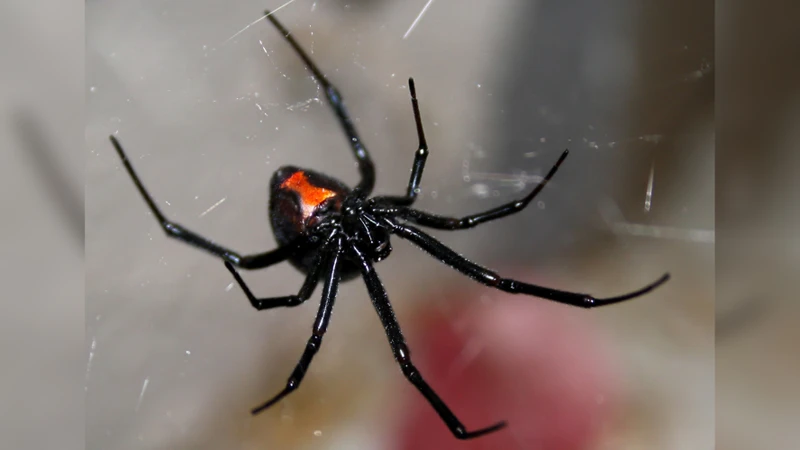
While black widow spiders may be fascinating to observe from afar, they pose significant risks and dangers to humans and pets. These spiders are not only known for their venomous bites but also for their aggressive behavior when they feel threatened or disturbed. It is crucial to understand the potential hazards associated with black widow spiders and how to prevent infestations in your home. In this section, we will explore the various risks and dangers of black widow spiders in detail, providing insight into the potential threats that males and females pose. Let’s dive in!
Threats to Humans
Black widow spiders are notorious for their dangerous venom and can pose a serious threat to humans. Here are some of the specific ways black widow spiders can pose a danger to humans:
- Black widow spider bites: The bite of a female black widow spider can cause mild to severe symptoms in humans. People who are bitten by black widows often experience pain, muscle stiffness, cramping, and abdominal discomfort. In some cases, bites can cause a dangerous reaction called latrodectism, which can lead to muscle spasms, seizures, and even death.
- Unintentional encounters: Black widow spiders are known to build webs in dark, secluded areas, such as basements, closets, and attics. Unintentional encounters with these spiders can lead to accidental bites, especially if a person reaches into a hidden area without looking first.
- Outdoor encounters: Black widow spiders can be found in gardens, woodpiles, and other outdoor areas. Encounters with these spiders can occur while hiking, gardening, or performing other outdoor activities.
- Secondary infections: While black widow spider bites themselves don’t typically cause infections, scratching or rubbing the bite site can introduce bacteria into the wound and cause a secondary infection.
It’s important to take precautions to prevent encounters with black widow spiders and seek medical attention if bitten. Always wear protective clothing when working in dark or secluded areas, and make sure to inspect these areas thoroughly before reaching in. If bitten by a black widow spider, seek medical attention immediately.
Threats to Pets
Pets, just like humans, can be at risk of being bitten by a black widow spider. However, the severity of the pet’s reaction to a black widow bite can vary greatly depending on their size, age, and overall health. In this section, we will discuss some of the potential threats to pets from black widow spiders.
| Pet Type | Threat Level |
| — | — |
| Dogs | Generally low, except for smaller or sickly dogs |
| Cats | Generally low |
| Birds | High |
| Reptiles | High |
Dogs are usually less at risk because of their larger body size. However, smaller or sickly dogs can be at higher risk and may experience severe symptoms such as vomiting, diarrhea, muscle tremors, and even respiratory distress.
Cats are generally more resilient to black widow spider bites, but they too can experience severe symptoms such as muscle stiffness and increased heart rate. Birds and reptiles are at a higher risk of severe reactions to black widow bites, and it’s recommended to keep them out of areas where black widows are likely to be found.
If you suspect that your pet may have been bitten by a black widow spider, it’s important to seek veterinary care immediately. Treatment for pets may include medication to alleviate symptoms such as pain, muscle tremors, and vomiting. In severe cases, pets may require hospitalization for supportive care such as intravenous fluids and respiratory support.
While the risk to pets from black widow spiders is generally low, it’s important to take precautions to keep them safe. Regularly inspecting outdoor areas and keeping a clean and tidy home can help prevent infestations and potential bites.
Preventing Male and Female Black Widow Spider Infestations
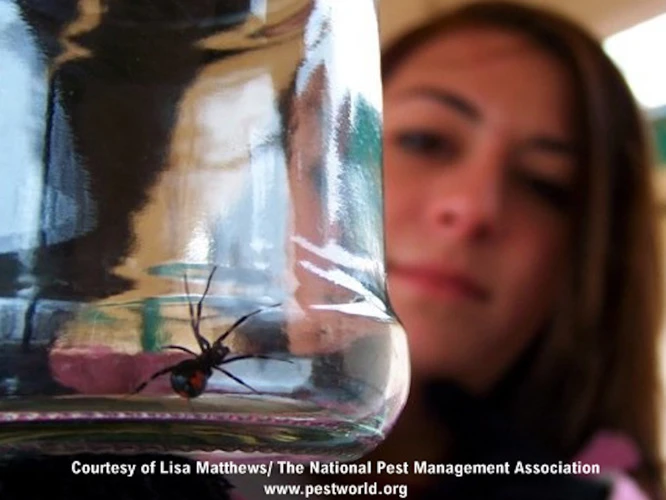
To prevent male and female black widow spider infestations, it is essential to create an environment that is not conducive to their survival. Here are some tips to keep your home spider-free:
1. Keep your surroundings clean: A clean home and yard will reduce the likelihood of a black widow spider infestation. The spiders thrive in cluttered areas, so make sure to keep your home, garage, and yard debris-free.
2. Seal your home: Inspect your home for any gaps and crevices and seal them up to prevent spider entry. Check for holes in window screens and doors and repair them so that spiders cannot crawl through them.
3. Store firewood away from your home: Firewood piles are an ideal location for black widow spiders to hide out. It is the perfect breeding ground for them, and they can easily make their way into your home from there. Store firewood well away from your house, garage, or any other structure on your property.
4. Remove spider webs: Regularly sweep and vacuum your home to remove spider webs. Spider webs are often the first visible sign of a spider infestation, so it’s essential to remove them quickly.
5. Use insecticides: If you have a severe infestation, using insecticides can be an effective way to kill the spiders. However, ensure you follow the safety guidelines provided by the manufacturer when using insecticides.
By following these tips, you can reduce the likelihood of a black widow spider infestation in your home. However, it’s always best to consult a professional pest control company if you suspect an infestation. A professional can help you identify the extent of the infestation and develop an effective treatment plan.
Black Widow Spider Control and Treatment
If you suspect a black widow spider infestation or have been bitten by one, it is important to take immediate action. The first step is to seek medical attention if you are experiencing symptoms such as nausea, muscle cramps, sweating, or difficulty breathing. Anti-venom treatments are available and can significantly reduce the effects of black widow spider venom.
In addition to seeking medical attention, controlling and treating black widow spider infestations is critical to preventing future bites. The following methods can be used to control and treat black widow spider infestations:
1. Use Insecticides: Insecticides can be an effective way to control black widow spider populations. However, it is important to use them with caution as they can be toxic if misused. It is recommended to use insecticides only as a last resort and to follow the instructions on the label carefully.
2. Reduce Clutter: Black widow spiders are attracted to cluttered areas where they can hide and build their webs. Removing clutter and keeping your home or yard clean and organized can help reduce the risk of infestation.
3. Seal Entry Points: Preventing black widow spiders from entering your home or building is critical to preventing infestations. Seal any cracks, gaps, or holes in walls, windows, doors, and foundations where spiders can enter.
4. Keep Outdoor Lighting to a Minimum: Black widow spiders are attracted to light sources, so keeping outdoor lighting to a minimum can help reduce the risk of infestation.
5. Hire a Professional: If you are experiencing a severe infestation or are unsure how to control and treat a black widow spider infestation, it is best to consult with a professional pest control company who can provide safe and effective treatments.
Taking steps to prevent and control black widow spider infestations is crucial to ensuring the safety and well-being of you and your family. With the right precautions and treatments, you can minimize the risk of bites and keep these dangerous spiders at bay.
Differences Between Male and Female Black Widow Spiders: Conclusion
It is clear that male and female black widow spiders have significant differences in terms of appearance, behavior, and reproduction. Male black widow spiders are generally smaller in size and are less venomous than their female counterparts. They also have unique physical characteristics that distinguish them from females, such as their longer legs and smaller abdomen.
Female black widow spiders, on the other hand, are larger and have a more prominent black or brown body with a characteristic red or orange hourglass-shaped marking on their abdomen. They are also known for their aggressive behavior, especially during mating season, which can pose a danger to humans and pets. Additionally, female black widows are capable of producing up to 9 egg sacs in a single lifetime, with each sac containing up to 900 eggs.
It is important to know how to identify male and female black widow spiders, as well as to take steps to prevent infestations and stay safe from bites. Home remedies can be used to encourage separation of male and female spiders from homes, and black widow spider control and treatment can also be effective in getting rid of an infestation.
Understanding the differences between male and female black widow spiders is crucial for anyone who lives in areas where these arachnids are common. By taking appropriate precautions and seeking professional help when necessary, we can minimize the risks associated with black widow spider infestations and protect ourselves and our loved ones from harm.
Frequently Asked Questions
1. Are male black widow spiders dangerous to humans?
No. Male black widow spiders do not pose a threat to humans because they lack the venomous bite that females have.
2. Can you tell the difference between male and female black widow spiders by their webs?
No, it is not possible to differentiate between male and female black widow spiders based on their webs alone.
3. What should I do if I find a black widow spider in my home?
It’s best to call a professional pest control company to remove the spider safely and effectively.
4. Can black widow spider bites be deadly?
Yes, in rare cases, black widow spider bites can cause serious medical complications, especially in children, the elderly, and those with weakened immune systems.
5. How do female black widow spiders attract males?
Female black widow spiders release pheromones, chemicals that are picked up by the male’s sensory organs, to attract them for mating.
6. Do male black widow spiders engage in courtship behavior with females?
Yes, male black widow spiders will engage in courtship behavior with females to attract their attention for mating.
7. How many offspring can a female black widow spider produce?
A female black widow spider can produce up to 400 eggs in a single clutch, but it’s more common for them to lay around 100-200 eggs.
8. How can you identify a black widow spider?
Black widow spiders typically have a shiny black body with a distinctive red hourglass-shaped marking on the abdomen.
9. What is the life span of a male black widow spider?
Male black widow spiders typically live for several months to a year, while females can live for up to three years.
10. Can I use DIY home remedies to control black widow spider infestations?
While there are DIY home remedies that claim to control black widow spiders, it’s best to call a professional pest control company for effective and safe removal.






